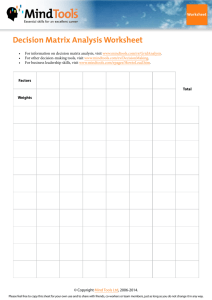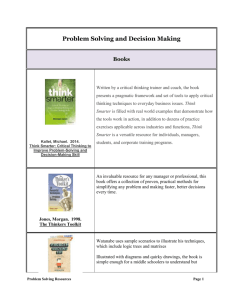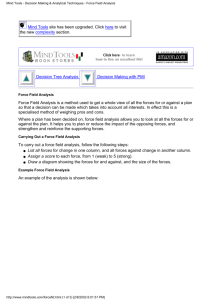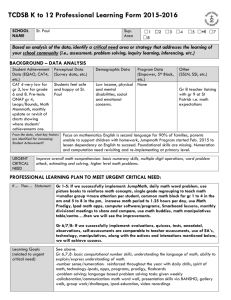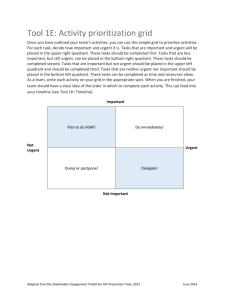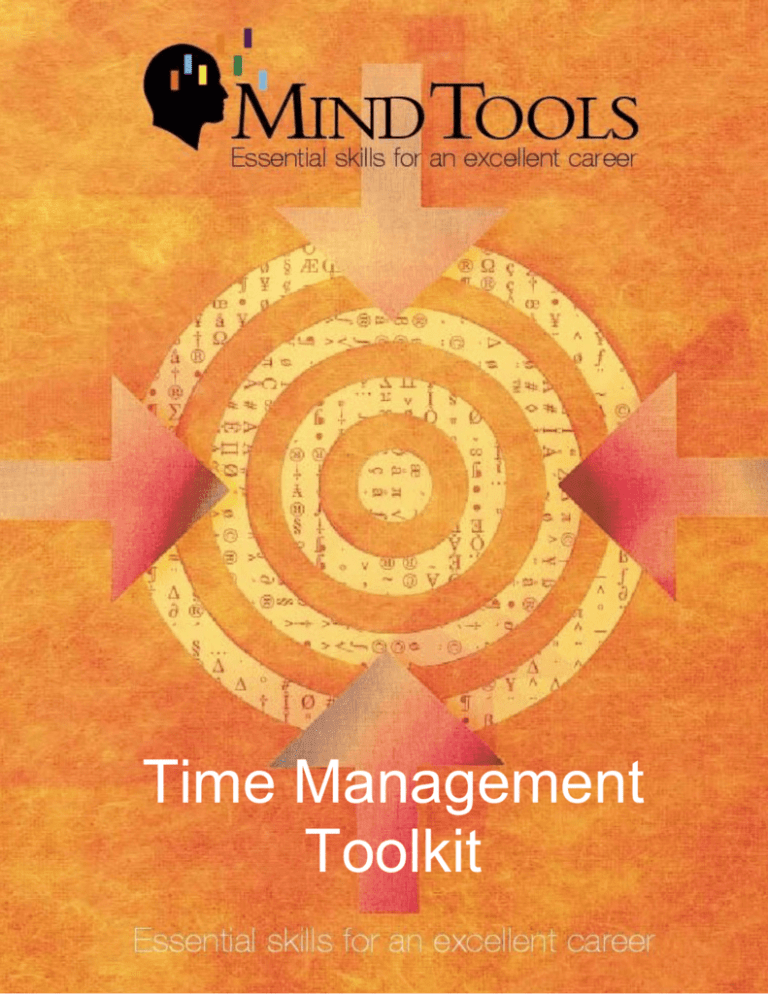
Time Management
Toolkit
Time Management Toolkit
MindTools.com
Time Management Toolkit
This e-booklet is published by:
Mind Tools Limited
Copyright © Mind Tools 2009. All rights reserved.
Version 1.0
© Mind Tools Ltd, 2009.
2
Time Management Toolkit
MindTools.com
Time Management Toolkit
Welcome to the Mind Tools Time Management Toolkit!
The tools it contains are the simple, practical – but powerful – techniques that have
helped the leading people in business, sport and public service reach the pinnacles of
their careers.
The skills we explain help you become highly effective, by showing you how to identify
and focus on the activities that give you the greatest returns. Investing in these time
management activities will actually save you time, helping you work smarter, not harder.
What's more, these same techniques help you beat work overload – a key source of
stress.
Enjoy finding out about them – and benefitting from putting them into practice!
About MindTools
Each year MindTools.com helps more than 6.7 million
visitors from around the world learn the "essential skills for
an excellent career!" Online since 1995, we publish the
practical, proven skills and techniques that help managers
and professionals achieve high personal effectiveness,
become exceptional leaders, become successful… and be
happy at work and in life.
© Mind Tools Ltd, 2009.
3
Time Management Toolkit
MindTools.com
Contents
Activity Logs ...................................................................................................................... 5
To-Do Lists........................................................................................................................ 6
The Urgent/Important Matrix ............................................................................................. 8
The Action Priority Matrix ................................................................................................ 10
Managing Interruptions ................................................................................................... 12
The Art of Filing............................................................................................................... 16
Next Steps....................................................................................................................... 20
© Mind Tools Ltd, 2009.
4
Time Management Toolkit
MindTools.com
Activity Logs
Finding out how you really spend your time
How long do you spend each day on unimportant things; Things that don't really
contribute to your success at work? Do you KNOW how much time you've spent reading
junk mail, talking to colleagues, making coffee and eating lunch? And how often have
you thought, ‘I could achieve so much more if I just had another half hour each day.’
And are you aware of when in the day you check your e-mail, write important articles or
do your long-term planning?
Most people find they function at different levels of effectiveness at different times of day
as their energy levels fluctuate. Your effectiveness may vary depending on the amount
of sugar in your blood, the length of time since you last took a break, routine distractions,
stress, discomfort, or a range of other factors.
Activity logs help you to analyze how you actually spend your time. The first time you
use an activity log you may be shocked to see the amount of time that you waste!
Memory is a very poor guide when it comes to this, as it can be too easy to forget time
spent on non-core tasks.
How to Use the Tool
Keeping an Activity Log for several days helps you to understand how you spend your
time, and when you perform at your best. Without modifying your behavior any further
than you have to, note down the things you do as you do them on our Activity Log
template which can be downloaded here. Every time you change activities, whether
opening mail, working, making coffee, gossiping with colleagues or whatever, note down
the time of the change.
As well as recording activities, note how you feel, whether alert, flat, tired, energetic, etc.
Do this periodically throughout the day. You may decide to integrate your activity log with
a stress diary.
Learning from Your Log
Once you have logged your time for a few days, analyze your daily activity log. You may
be alarmed to see the amount of time you spend doing low value jobs!
You may also see that you are energetic in some parts of the day, and flat in other parts.
A lot of this can depend on the rest breaks you take, the times and amounts you eat, and
quality of your nutrition. The activity log gives you some basis for experimenting with
these variables.
Your analysis should help you to free up extra time in your day by applying one of the
following actions to most activities:
1. Eliminate jobs that your employer shouldn't be paying you to do. These may
include tasks that someone else in the organization should be doing, possibly at a
lower pay rate, or personal activities such as sending non-work e-mails.
© Mind Tools Ltd, 2009.
5
Time Management Toolkit
MindTools.com
2. Schedule your most challenging tasks for the times of day when your energy is
highest. That way your work will be better and it should take you less time.
3. Try to minimize the number of times a day you switch between types of task. For
example, read and reply to e-mails in blocks once in the morning and once in the
afternoon only.
4. Reduce the amount of time spent on legitimate personal activities such as making
coffee (take turns in your team to do this – it saves time and strengthens team
spirit).
Key Points
Activity logs are useful tools for auditing the way that you use your time. They can also
help you to track changes in your energy, alertness and effectiveness throughout the
day.
By analyzing your activity log you will be able to identify and eliminate time-wasting or
low-yield jobs. You will also know the times of day at which you are most effective, so
that you can carry out your most important tasks during these times.
To-Do Lists
The key to efficiency
Do you frequently feel overwhelmed by the amount of work you have to do? Do you face
a constant barrage of looming deadlines? Or do you sometimes just forget to do
something important, so that people have to chase you to get work done?
All of these are symptoms of not keeping a proper ‘To-Do List’. To-Do Lists are
prioritized lists of all the tasks that you need to carry out. They list everything that you
have to do, with the most important tasks at the top of the list, and the least important
tasks at the bottom.
While this sounds a simple thing to do, it's when people start to use To-Do Lists properly
that they often make their first personal productivity/time management breakthrough,
and start to make a real success of their careers.
By keeping a To-Do List, you make sure that you capture all of the tasks you have to
complete in one place. This is essential if you're not going to forget things. And by
prioritizing work, you plan the order in which you'll do things, so you can tell what needs
your immediate attention, and what you can quietly forget about until much, much later.
This is essential if you're going to beat work overload. Without To-Do Lists, you'll seem
dizzy, unfocused and unreliable to the people around you. With To-Do Lists, you'll be
much better organized, and will seem much more reliable. This is very important!
Preparing a To-Do List
Before you start preparing your To-Do List, first download an editable pdf copy of our ToDo List template here.
© Mind Tools Ltd, 2009.
6
Time Management Toolkit
MindTools.com
Then start by writing down all of the tasks that you need to complete, and if they are
large, break them down into their component elements. If these still seem large, break
them down again. Do this until you have listed everything that you have to do, and until
tasks are will take no more than 1-2 hours to complete. This may be a huge and
intimidating list, but our next step makes it manageable!
Next, run through these jobs allocating priorities from A (very important, or very urgent)
to F (unimportant, or not at all urgent). If too many tasks have a high priority, run through
the list again and demote the less important ones. Once you have done this, rewrite the
list in priority order.
You will then have a precise plan that you can use to eliminate the problems you face.
You will be able to tackle these in order of importance or urgency. This allows you to
separate important jobs from the many time-consuming trivial ones.
Tip:
Once you're comfortable with use of To-Do Lists, you need to start differentiating
between urgency and importance. For more on this, see our article on the
Urgent/Important Matrix.
Using Your To-Do Lists
Different people use To-Do Lists in different ways in different situations: if you are in a
sales-type role, a good way of motivating yourself is to keep your list relatively short and
aim to complete it every day.
In an operational role, or if tasks are large or dependent on too many other people, then
it may be better to keep one list and ‘chip away’ at it.
It may be that you carry unimportant jobs from one To-Do List to the next. You may not
be able to complete some very low priority jobs for several months. Only worry about this
if you need to – if you are running up against a deadline for them, raise their priority.
If you have not used To-Do Lists before, try them now: They are one of the keys to being
really productive and efficient.
Key Points
Prioritized To-Do Lists are fundamentally important to efficient work. If you use To-Do
Lists, you will ensure that:
•
•
•
•
You remember to carry out all necessary tasks
You tackle the most important jobs first, and do not waste time on trivial tasks.
You do not get stressed by a large number of unimportant jobs.
To draw up a Prioritized To-Do List, download our template and use it to list all the
tasks you must carry out. Mark the importance of the task next to it, with a priority
from A (very important) to F (unimportant). Redraft the list into this order of
importance.
Now carry out the jobs at the top of the list first. These are the most important, most
beneficial tasks to complete.
© Mind Tools Ltd, 2009.
7
Time Management Toolkit
MindTools.com
The Urgent/Important Matrix
Using time effectively, not just efficiently
We've all been there: The project is due for today's meeting and we are only three
quarters done. Our anxiety is at its peak, we can't concentrate, everything is a
distraction, and then, finally, we blow. Time stressors are the most pervasive source of
pressure and stress in the workplace and they happen as a result of having too much to
do in too little time.
With this kind of pressure all too common, effective time management is an absolute
necessity. You probably use a day-planner and to-do list to manage your time. These
tools are certainly helpful, but they don't allow you to drill down to one of the most
essential elements of good time management: Distinguishing between what is important
and what is urgent.
Great time management means being effective as well as efficient. Managing time
effectively, and achieving the things that you want to achieve, means spending your time
on things that are important and not just urgent. To do this, and to minimize the stress of
having too many tight deadlines, you need to distinguish clearly between what is urgent
and what is important:
• Important activities have an outcome that leads to the achievement of your goals.
• Urgent activities demand immediate attention, and are usually associated with the
achievement of someone else's goals, or with an uncomfortable problem or
situation that needs to be resolved.
Urgent activities are often the ones we concentrate on. These are the "squeaky wheels
that get the grease." They demand attention because the consequences of not dealing
with them are immediate.
The Urgent/Important Matrix is a useful tool for thinking about this.
The idea of measuring and combining these two competing elements in a matrix has
been attributed to both former US President Eisenhower and Dr Stephen Covey.
Eisenhower's quote, "What is important is seldom urgent and what is urgent is seldom
important," sums up the concept of the matrix perfectly. This so-called "Eisenhower
Principle" is said to be how Eisenhower organized his tasks.
Covey brought the idea into the mainstream and gave it the name "The
Urgent/Important Matrix" in his 1994 business classic, 7 Habits of Highly Effective
People.
How to Use the Tool:
The Urgent/Important Matrix is a powerful way of thinking about priorities. Using it helps
you overcome the natural tendency to focus on urgent activities, so that you can keep
clear enough time to focus on what's really important. This is the way you move from
"firefighting", into a position where you can grow your business and your career.
© Mind Tools Ltd, 2009.
8
Time Management Toolkit
MindTools.com
Here's how it works:
The matrix can be drawn as shown in figure 1, with the dimensions of Importance and
Urgency.
Figure 1: Urgent/Important Matrix
High
“Critical Activities”
“Distractions”
“Interruptions”
Importance
“Important Goals”
Low
Low
Urgency
High
The steps below help you use the matrix to prioritize your activities:
1. The first step is to list all the activities and projects you feel you have to do. Try to
include everything that takes up your time at work, however unimportant. (If you
manage your time using an Action Program, you'll already have done this.)
2. Next, assign importance to each of the activities – you can do this on, say, a
scale of 1 to 5: Remember, this is a measure of how important the activity is in
helping you meet your goals and objectives. Try not to worry about urgency at
this stage, as this helps get to the true importance.
3. Once you have assigned importance to each activity, evaluate the urgency to
each activity. As you do this, you can plot the listed items on the matrix according
to the assigned importance and urgency.
4. Now study the matrix using the following strategies described below to schedule
according to your priorities.
Strategies for Different Quadrants of the Matrix
Urgent and Important
There are two distinct types of urgent and important activities: Ones that you could not
foresee, and others that you have left to the last minute.
You can avoid the latter by planning ahead and avoiding procrastination.
Issues and crises, on the other hand, cannot always be foreseen or avoided. Here, the
best approach is to leave some time in your schedule to handle unexpected issues and
© Mind Tools Ltd, 2009.
9
Time Management Toolkit
MindTools.com
unplanned important activities. And if a major crisis arises, some other activity may have
to be rescheduled.
If this happens, identify which of you urgent-important activities could have been
foreseen and think about how you could schedule similar activities ahead of time, so
they do not become urgent.
Urgent and Not Important
Urgent but not important activities can be a constant source of interruption. They stop
you achieving your goals and completing your work. Ask yourself whether these tasks
can be rescheduled, or whether someone else could do them.
A common source of such interruptions is from other people in your office. Sometimes
it's appropriate to say "No" to people, or encourage them to solve the problem
themselves. Alternatively, try allocating time when you are available so that people only
interrupt you at certain times (a good way of doing this is to schedule a regular meeting
so that all issues can be dealt with at the same time.) By doing this, the flow of work on
your important activities will be less disrupted.
Not Urgent, but Important
These are the activities that you can plan ahead for to achieve your goals and complete
your work. Make sure that you have plenty of time to achieve these, so that they do not
become urgent. And remember to leave enough time in your schedule to deal with
unforeseen problems. This will maximize your chances of keeping on schedule, and help
you avoid the stress of work becoming more urgent that necessary.
Not Urgent and Not Important
These activities are just a distraction, and should be avoided if possible. Some can
simply be ignored. Others are activities that other people want you to do, but they do not
contribute to your own desired outcomes. Again, say "No" politely and firmly if you can.
If people see you are clear about your objectives and boundaries, they will often not ask
you to do "not important" activities in future.
Key Points
The Urgent/Important Matrix helps you look at your task list, and quickly identify the
activities you should focus on. By prioritizing using the Matrix, you can deal with truly
urgent issues, at the same time that you keep on working towards your goals.
The Action Priority Matrix
Making the very most of your opportunities
(Also called the Impact Feasibility Matrix)
The Action Priority Matrix is a simple diagramming technique that helps you choose
which activities to prioritize (and which ones you should drop) if you want to make the
most of your time and opportunities.
© Mind Tools Ltd, 2009.
10
Time Management Toolkit
MindTools.com
It's useful because most of us have many more activities on our "wish lists" – whether
these are bright ideas to pursue, exciting opportunities or interesting possibilities – than
we have time available. By choosing activities intelligently, you can make the very most
of your time and opportunities.
However by choosing badly, you can quickly bog yourself down in low-yield, timeconsuming projects that close down opportunities and stop you moving forwards.
How to Use the Tool:
Figure 1 below shows the basic form of the Action Priority Matrix:
Figure 1: Action Priority Matrix
High
“Quick Wins”
“Major Projects”
“Fill Ins”
“Thankless Tasks”
Impact
Low
Low
Effort
High
The principle behind using the tool is that you score each activity you want to complete
on two scales – firstly on the impact the activity will have, and secondly on the effort
involved.
By plotting each activity on the Action Priority Matrix using these scores, you can quickly
see the projects that give you the greatest returns on your efforts; and adopt the most
appropriate approach for that type of activity:
• Quick Wins (High Impact, Low Effort): These are the most attractive projects,
giving you a good return for relatively little effort. Focus on these as much as you
can.
• Major Projects (High Impact, High Effort): While these give good returns, they
take a long time to complete – meaning that one "Major Project" can crowd out many "Quick
Wins". If you're engaging in these, make sure that you complete them quickly and
efficiently and that you disengage your effort as soon as you can.
• Fill Ins (Low Impact, Low Effort): Don't worry too much about doing these – if
you've got spare time, do them, but drop them if something better comes along.
• Thankless Tasks (Low Impact, High Effort): Avoid these. Not only do they give
low returns, they crowd out time which would be better used elsewhere.
© Mind Tools Ltd, 2009.
11
Time Management Toolkit
MindTools.com
Tip 1:
Much of the "magic" of this technique comes from understanding and avoiding this
crowding out effect.
Tip2:
A variant of this tool is the "Impact-Feasibility Matrix", which substitutes 'Feasibility' for
'Effort' on the horizontal axis. This gives a different perspective, looking at the
organization's ability to deliver important changes.
To use the Action Priority Matrix, print off our free worksheet and then follow these
steps:
1. List the activities that you'd like to complete.
2. Score them on impact (from, say, 0 for no impact to 10 for maximum impact) and
on effort involved (from 0, say, for no real effort to 10 for a very major effort).
3. Plot the activities on the Action Priority Matrix.
4. Select or drop activities appropriately.
Tip 3:
Use common sense in interpreting the lines separating the four quadrants – after all,
there's only a small difference between a 4.9 impact activity defined as a "thankless
task", and a 5.1 impact task defined as a "major project".
Tip 4:
Above we're suggesting a scale from 0 to 10 for both impact and effort. However
there's nothing stopping you using other scales – for example if you were ranking
major projects, you might use $ financial return as the scale on the impact axis, and
"man days activity" on the effort axis.
This is just one of Mind Tools' personal effectiveness techniques. Click here to see more
on Make Time for Success, Mind Tools' time management and personal effectiveness
program.
Managing Interruptions
Maintain focus. Keep control of your time.
Everyday interruptions at work can be a key barrier to managing your time effectively
and, ultimately, a barrier to your success.
Think back to your workday yesterday and consider for a minute the many interruptions
that occurred. They may have been phone calls, emails, hallway conversations,
colleagues stopping by your office, or anything else that unexpectedly demanded your
attention and, in doing so, distracted you from the task at-hand.
Because your day only has so many hours in it, a handful of even the smallest
interruptions can rob you of the time you need to achieve your goals and be successful
in your work and life.
© Mind Tools Ltd, 2009.
12
Time Management Toolkit
MindTools.com
More than this, they can break your focus, meaning that you have to spend time reengaging with the thought processes needed to successfully complete complex work.
The key to controlling interruptions is to know what they are and whether they are
necessary, and to plan for them in your daily schedule when they truly need your
attention. The tips that follow will help you do that and so prevent interruptions from
frustrating you and jeopardizing your success.
Using the Tool
Use the following tips to understand and manage interruptions:
1. Keep An Interrupters Log
If interruptions consistently rob you of time and energy, or if they frequently push you off
schedule and cause delays, it's time to keep an Interrupters Log. This is a simple record
of the interruptions you experience in the course of a day.
Click here to download our free Interrupters Log Worksheet. Figure 1 shows an example
of it.
Figure 1: The Interrupters Log
Person
Date and Time
Description of
Interruption
Valid?
Urgent?
Keep your Interrupters Log with you every day for at least a week, recording every
interruption you experience, and marking down the person interrupting you; the date and
time it occurs; what the interruption is; whether it was valid; and whether it was urgent
(or whether someone could have waited until a better time.)
This allows you to more accurately identify the interruptions that are causing you to fall
behind or to experience time crunches and delays.
Once you have recorded the interruptions for a week, sit down with your log and analyze
the information.
Which interruptions are valid and which are not?
You need to deal with the valid interruptions. We'll show you below how you can
schedule them into your day so that they get the attention they need, while you still have
the time you need to adequately address these and complete your daily work.
As for the interruptions that are not valid, you must find a way to block these out in the
future or the productivity that will suffer is your own!
© Mind Tools Ltd, 2009.
13
Time Management Toolkit
MindTools.com
2. Analyze and Conquer Interruptions
To analyze and conquer the interruptions you find in your Interrupters Log, firstly look at
whether the interruption is valid or not.
Could someone have avoided interrupting you by waited for a routine meeting? Or was it
something they should have asked you about at all?
If not, deal with this politely but assertively.
Next, look at how urgent the interruptions were, and whether they could have been preempted. You can pre-empt many interruptions by holding routine meetings with people:
If they're confident that they'll have access to you at a defined point in the near future,
they'll learn to save up non-urgent issues until this meeting.
However, some interruptions are both urgent and valid. You need to be interrupted, and
you need to deal with the situation.
From your Interrupters Log, you'll see how much time is taken up by these urgent, valid
interruptions. Block this time into your schedule as "contingency time", and only take on
as much other work as you can fit into the remaining time. You'll have to juggle this other
work around the interruptions, but at least you won't be overloaded and stressed by the
things that you haven't done because they've been displaced by emergencies.
3. Put Your Phone to Work for You (Not Against You)
A little bit of planning can go a long way in working to control telephone interruptions,
which most people experience all day long. If you are on a deadline or your focus needs
to be intense (and not interrupted), use your voice mail to screen calls or have an
assistant deal with messages for you. This way, you can deal with calls by priority at
times that suit you. In fact, this telephone time can be planned into your schedule, and
so become a normal part of your working pattern.
4. Catch Your Breath
When interrupted, it's easy to get caught up in the "rush" of the person who is
interrupting, for they undoubtedly feel their request is urgent. In reality, however, most
interruptions are not a crisis and it serves everyone best to take a little time before taking
action.
Take a few minutes to consider the situation. Catch your breath and clear your head. A
small delay, even one of just a few minutes, goes a long way in assessing the situation
accurately and reacting appropriately.
5. Learn to Say "No"
It's often acceptable to say "no" to requests or tasks if you are busy when someone else
can handle it, if it is not an important task, or if it can be done later.
When this is the case, saying "no" in a courteous and sincere way, followed by a short
explanation is the best course of action to take: "I am working against a very tight
deadline on an important project right now so, I am sorry, but I can not jump in and help".
© Mind Tools Ltd, 2009.
14
Time Management Toolkit
MindTools.com
6. "Available" and "Unavailable" Time
Simple yet effective: Let people know when you are available. and when you are not.
Make sure that people know that during your "unavailable time", they should only
interrupt you if they have to.
You and your co-workers can also agree on a signal that everyone in the office can use
when tied up and unavailable, like turning the nameplate on the door around, or simply
closing the door. This alleviates interruptions and can avoid hurt feelings.
Tip:
Be careful here. If you're a manager, an important part of your job is to be available to
people, to handle urgent issues which arise, and to coach your team so that people
are as effective as possible.
If you put up barriers that are too high, you won't be able to do these jobs. By all
means, use "unavailable time", but don't over use it, and make sure people know they
can interrupt you if there is a genuine crisis.
7. "Invitation Only" Time
Schedule regular check-in times for the individuals you talk to most often. Ask these
people to keep a running list of things that they need to discuss, so you can cover all the
points at one time. And, force yourself to do the same.
An open-door policy is good, but you should limit the number of people you invite to your
work area. For instance, if you're scheduling a meeting, offer to meet your co-worker in
his or her office or a conference room. This way, you can excuse yourself after you
accomplish your purpose. Additionally, it's much easier to get up and leave than it is to
get people to leave your office once seated and comfortable there.
8. Uncontrollable Interruptions
There are interruptions that, no matter how hard you try, you simply cannot control.
Most people are happy to schedule a more convenient time, but when this does not
work, quickly set the parameters by saying something like, "I only have five minutes to
talk about this right now," and stick to it.
Do not ask the interrupter to sit down and do not engage in small talk. Encourage the
interrupter to get right to the point and if a solution cannot be reached before the allotted
time runs out, set a time for getting back to them and, again, stick to it.
© Mind Tools Ltd, 2009.
15
Time Management Toolkit
MindTools.com
The Art of Filing
Managing Your Documents... and Your Time
Have you ever sat there while your boss stands over you, desperately searching for that
missing document he or she needs RIGHT NOW? Or have you kept a client waiting on
the phone for several minutes while you've searched for a status report?
If you have, then however organized and effective you are in your day-to-day work, your
boss and your client may have a less than perfect opinion of you, because in a key
encounter, you've let them down. And if it's your job to help people, how much of other
people's time are you wasting if you can't find the information you need when you need
it?
You owe it to yourself to file effectively, however boring this may seem. Imagine how
much more impressive it would have been if – when asked – you'd smiled, accessed a
well-organized filing system, immediately found the document, and quickly given the
answer!
Managing Time
On a typical work day, we deal with many documents, presentations, graphics, and other
files. There's a flurry of data pouring in from all directions that we need to process and,
usually, store to retrieve later. We want to be able to lay our hands on the information we
need – at the right moment, when we need it – so it can be used for further analysis or
report writing, or perhaps for creating a presentation.
All too often, though, we waste our own time (and often the time of other people)
searching for data that's sitting on the very computer we're using! This adds to our
stress, and makes the task of putting the data to use more difficult than it ought to be. So
we need to get more organized and efficient with our file management if we're going to
get our work done in a timely manner.
Managing Information Efficiently
When you receive a file in an e-mail from a co-worker, vendor, or customer, it's tempting
to "just put it away" in some folder for the time being. "Hmm. looks interesting, but I'll
take a closer look at this later, when I've got more time." Sound familiar? Or, worse still,
perhaps you just leave the message and its attachment sitting in your Inbox. After a
while, many such documents build up, leading to a lot of clutter. It's highly unlikely that
you'll ever find time to go back and get all of that information organized, especially
considering that you're usually under pressure with other things and have hectic work
schedules to meet.
You can spend hours of precious time searching for data you've filed away somewhere,
because it's easy to forget the filename – or even to forget that such information is on
your computer in the first place. How can you go about simplifying your work? Get better
at managing files.
© Mind Tools Ltd, 2009.
16
Time Management Toolkit
MindTools.com
Effective File Management
Managing files on your computer isn't much different from the way you've always stored
and managed your paper files. It boils down to this: Store the information in folders – by
category, and in a sequence that makes sense to you.
Here are some tips to help manage your files:
• Avoid saving unnecessary documents. Don't make a habit of saving just about
everything that finds its way into your Inbox. Take a few seconds to glance through
the content, and save a file only if it's relevant to your work activity. Having too
much data on your computer adds to the clutter that makes it harder to find things
in the future – and it may, over time, slow down your computer's performance too –
so be selective about what you keep.
• Follow a consistent method for naming your files and folders. For instance,
divide a main folder into subfolders for customers, vendors, and co-workers. Give
shortened names to identify what or whom the folders relate to. What's more, you
can even give a different appearance or look to different categories of folders – this
can make it easy to tell them apart at first glance.
• Store related documents together, whatever their type. For example, store
Word documents, presentations, spreadsheets, and graphics related to a particular
project in a single folder – rather than having one folder for presentations for all
projects, another folder for spreadsheets for all projects, and so forth. This way, it's
much quicker to find, open, and attach documents for a particular project.
• Separate ongoing work from completed work. Some people prefer to save
current or ongoing work on their computer's desktop until a job is completed. Then,
once it's done, they move it to the appropriate location, where files of the same
category are stored. At periodic intervals (for example, weekly or every two
weeks), move files you're no longer working on to the folders where your
completed work is stored.
• Avoid overfilling folders. If you have a large number of files in one folder, or a
large number of subfolders in a main folder – so many that you can't see the entire
list on your screen without scrolling down – break them into smaller groups
(subfolders or sub-subfolders). Think of creating a sequential menu, arranged
either in chronological or alphabetical order, to make retrieval easy. For instance,
you can divide a folder called "Business Plan" into subfolders called "BP2005,"
"BP2006," and "BP2007." Likewise, you can divide a folder for a client named
Delta Traders into subfolders named "Delta Traders sales presentations" and
"Delta Traders contracts." The idea is to place every file into a logical folder or
subfolder, rather than have one huge list of files.
Having said this, there is usually little point in creating a folder for fewer than about
five documents. If you do, the time you spend clicking through subfolders to get to
the documents you need may not be outweighed by the greater ease of finding
them.
© Mind Tools Ltd, 2009.
17
Time Management Toolkit
MindTools.com
• Install Google Desktop on your PC. If you can (sometimes IT departments don't
permit this), install Google Desktop on your PC – you can find this at
http://desktop.google.com. This neat tool creates a desktop search engine that
indexes all of your files and emails, meaning that you can search for them quickly
and easily. This can be invaluable when you need to answer offbeat questions!
• Make sure your filing system is backed up. Again, this is a bit tedious, but it's
so important, as anyone who's had a failed disk drive will testify! Make sure, firstly,
that your PC is backed up regularly and, secondly, that the backup includes the
directories where you file information.
Prioritizing Your Files for Action
Take these approaches further by customizing your file management. This can help you
prioritize your work, which can lead to better efficiency.
• Organize files by dates. Incorporate a date into the file name. This will help you
determine which is the most recent document in the folder, without having to open
the file and read through the content. For example, a file named "Guidelines
12Oct07" would indicate a version of the Guidelines file dated October 12, 2007. (If
you're working internationally, be aware that in some countries this date can be
presented as 101207, while in other countries, this same date can be shown as
121007. This can be very confusing!)
• Some people use version numbers to distinguish between documents that have
been reworked or changed. Examples would be "Delta Traders contract v1" and
"Delta Traders contract v2." This also makes it easier to pick out the most current
file.
Tip:
If your document is going to be looked at, used, or amended by several people, you
need to be particularly careful about version control: People quite rightly can get very
annoyed if versions are mixed up and their work on the document is lost.
Make sure you put the version number in the file name here, and also consider
having a version control table at the beginning of the document showing the version
number, the date of the version, the person making changes, and, perhaps, the
nature of changes made.
• Use "Tickler" files. Tickler files, also known as the "43 folders" method, are a
unique system that's used by many people for organizing files. Create 12 folders
(one for each month of the year) and an additional 31 subfolders (for each day of
the month). Fill each folder with the documents that you need to work with on that
day. At the beginning of each day, open the folder for that day. Take all the items
out of the folder and move them into a "today" folder or onto your desktop. Then
move the empty folder into the corresponding slot for the next month. If you can't
complete some work items by the end of the day, transfer them to the folder for the
next convenient day. This system of file management helps you keep track of
everything you need to do, and it also doubles as a diary.
© Mind Tools Ltd, 2009.
18
Time Management Toolkit
MindTools.com
For any system to be useful and effective, it must also be convenient for you. To some
extent, this depends on the nature of your business or the work that you do. So,
although there's no "one size fits all" solution to file management, you will likely profit by
using some of these file management tips, and by customizing them in a way that best
serves your own needs.
Key Points
Are you losing too much time searching through the clutter on your computer for files
that you need? And when you're under pressure, can you retrieve information quickly
and easily?
Spending precious time looking for data can take the pleasure out of any kind of creative
work you might be doing – and it adds to your stress levels as well. Simple tips on file
management can show you how to get organized with your information storage and
retrieval.
Making This Part of Your Life:
We know this is boring, but you know you need to do it!
Clear an hour in your schedule somewhere in the next week, and set your filing
system up!
© Mind Tools Ltd, 2009.
19
Time Management Toolkit
MindTools.com
Next Steps
Explore for more!
For more information on this and other key career skills areas, visit
MindTools.com, and explore the many other free resources available
to you!
Mind Tools offers in excess of 450 management, career and thinking
skills resources, more than 250 of which you can use completely for
free. (The remainder are available to members of our members’ area,
the Career Excellence Club, and are accessible for a first month fee of
just US$1*.)
9
9
9
9
9
9
9
9
9
9
These skill-building articles help you quickly learn the skills you need
to work, lead and manage more effectively; helping you develop a
truly satisfying and successful career!
Leadership Skills
Team Management
Problem Solving
Decision Making
Project
Management
Practical Creativity
Time Management
Stress Management
Information Skills
Communication
Skills
Invest in you - take charge of your life and career for just US$1*!
*US$1 for month 1, then US$19 or US$27/month plus our no-quibble, cancel at any time, money-back guarantee.
The Mind Tools members’ area, the Career Excellence Club gives you
the career training and support you need to make a real success of
your career. It helps you to sharpen your skills and take your wisdom
and abilities to the next level, so that when career opportunities arise,
you'll be the natural choice to take advantage of them!
Within the community forums you’ll join a global network of managers,
professionals, coaches and experts, pleased to help you explore,
understand and resolve the career issues you face. This ‘on tap’
access to coaching and support makes career development and
personal growth a constant and ongoing part of your life.
9
9
9
9
9
9
9
9
9
Discussion Forums
Coaching Clinic
Self-Study Courses
Skill-Builders
Webinars
Expert Interviews
Book Insights
eClasses
Mentor Network
Join today and get 4
FREE career-enhancing
courses worth US$121!
www.MindTools.com/rs/CXC
You’ll also have access to more than 450 resources, all provided in
our proven, practical, easy-to-apply, tools-based approach, delivered
in bite-sized chunks that suit the way that busy people live and work. Click here to find out more!
Instant accessibility and cost-effective training for organizations
Online training is fast becoming an established part of many organizations’ training strategies, thanks to
the substantial cost savings and efficiency improvements it offers, compared to conventional soft skills
training. MindTools corporate membership provides organization-wide, instant access to the all the
MindTools training resources in one easy-to-own, easy-to manage, cost-effective package.
For more information contact our organization development team on +1 617 379 0748 (US),
+44 208 1445713 (US), corporate.enquiries@mindtools.com, or download our corporate brochure.
Enjoy exploring these skills, and start boosting your career right away!
James Manktelow, CEO, Mindtools.com
© Mind Tools Ltd, 2009.
20

